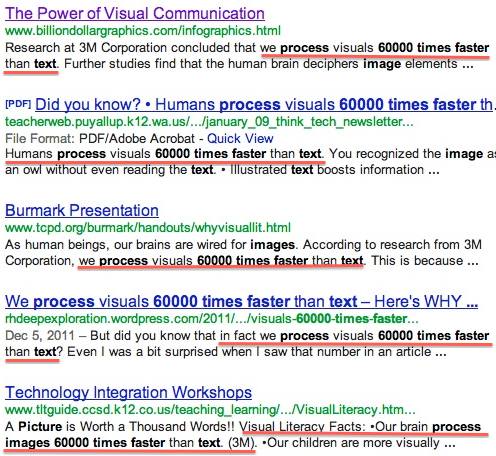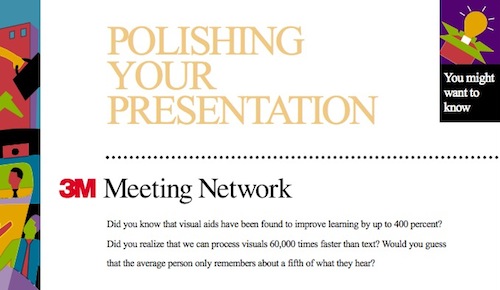
cc licensed ( BY NC SA ) flickr photo shared by Kalexanderson
Someone lend me a rope, I have fallen deep into one of those internet rabbit holes.
It began as a simple “I’ll look this up in a few minutes” query. I’d seen this quote in at least 2 presentations:
“images are processed 60,000 times faster than text”
A number like that smells like it comes from research. First cut google—
Most cite 3M as the research source, e.g. This ASTD book on Visual Literacy:
Research by 3M Corporation shows that people are able to process visual information 60,000 times more quickly than textual information
The link reference makes me feel a tad closer:
3M Corporation research cited in “Polishing Your Presentation.” 3M Meeting Network Articles & Advice (2001) [Online Article]. Available:http://www.3m.com/meetingnetwork/readingroom/meetingguide_pres.html
Except, alas, she is a dead link.
Enter the Internet Archive to the rescue
and the original PDF is still available:
Did you know that visual aids have been found to improve learning by up to 400 percent? Did you realize that we can process visuals 60,000 times faster than text? Would you guess that the average person only remembers about a fifth of what they hear?
These findings from behavioral research confirm our daily experience: we rely on all our senses to bring ideas and concepts to life. Effective presenters today realize that preparing to take the podium means more than having your index cards in order. As photos, illustrations, graphs and text make their way into presenters’ toolboxes, audiences are coming to expect impressive visual aids. However, high-quality images aren’t the whole story. Visuals should support you, not replace you. Use them instead to shed light on your key messages and capture the audience’s interest.
Yet nowhere have I been able to find any of this “behavioral research” just reference to it. The 3M publication is not research, it was actually more or less a sideways assertion for the value of their media offerings.
Yet all over the internet, this pseudofact is asserted as a truth, “research says 60,000 times faster” said enough times makes it– truthy?
I firmly believe the research is out there, and hoping maybe some of my more library or research experts can zero in on it for me… and in fact, I really don’t need to know it for anything specific, but at this point… we”ll I will saee you down the hole.

cc licensed ( BY ) flickr photo shared by jpockele




but… text *is* visual information. Unless it’s presented in braille or at 300 baud…
http://saldape1.blogspot.com/2011/10/chapter-7-synopsis-they-snooze-you.html
The last five lines of the post
– “Research has demonstrated that humans process visuals sixty thousand times faster than text.”
🙂 Will post again if I get any information. Maybe the online article has been taken down. Let me see if I can track it down.
http://books.google.com/books?hl=en&lr=&id=cb4xcSFkFtsC&oi=fnd&pg=PA5&dq=journal+t+3M+Corporation++process+visuals+60000+times+faster+than+text&ots=EwEIpRGJp8&sig=ex35jUdxY3opmsnqFCuRHIN5d7M#v=onepage&q&f=false
The authors made a reference between the end of page 7 and 8.
From https://docs.google.com/viewer?a=v&q=cache:vdLUg4A2T2sJ:safarimontagepa.wikispaces.com/file/view/Best%2BPractice%2Bfor%2BDigital%2BMedia%2Bin%2Bthe%2BClassroom.docx+&hl=en&gl=us&pid=bl&srcid=ADGEESjKTUOCI1tNVqG04WNjYQh0Y0WZxfXwIaJs0yiMQK3mcbERCoC_Qp2gsKFewsGFqoxmsJcT8hWuRydjrVjZKJq6ZhtWlBsaReSWll7SyAGBEcryKdCOdbEZ5riK2S8lOBKF2kb0&sig=AHIEtbSIrEB6YJAd9vR94xIHkKreJ70UWw&pli=1
3M Corporation (2001). Research cited in “Polishing Your Presentation.” 3M Meeting Network Articles & Advice (2001). Retrieved December 4, 2003, from:
http://www.3m.com/meetingnetwork/readingroom/meetingguide_pres.html
Hope this info will help you.
http://melsblog.edublogs.org/files/2008/12/vl_ebookp.pdf
– Look at the end of page 7 and 8
– Refer to bibliography reference #13 of the document.
It might help to read my original blog post(s) again, as I clearly cited that I located what all of these reference point to, a 3M brochure that makes the statement about humans processing images 60,000 times faster than text but never indicating the true source of the research this is based on. This is the point of my contention, that just citing this 3M PDF as a reference is not one that supports the assertion, it only repeats it.
Sorry, no winners here.
I found the actual article via Wayback Machine website. The 3M Meeting Network article made the claim that we can process visuals 60,000 times faster than text. My take on the issue is that it was just a claim probably for commercial gains. At this point, I have not found a scholarly research that support this claim.
The 3M article on the claim is at
http://web.archive.org/web/20040205103020/http://www.3m.com/meetingnetwork/files/meetingguide_pres.pdf
There was a 3M-sponsored research by the University Of Minnesota School of Management but the research did not make the claim. (http://www.thinktwiceinc.com/olio/articles/persuasion_article.pdf). How 3M came up with their conclusion is not known. Maybe it was just a claim and nothing more.
And thus the reason I started this. People have said it enough that it sound true.
But to date, no one has found any piece of research that supports this claim, and I find that fascinating and worrisome at the same time.
I already contacted the lead author of the Persuasion article, Doug Vogel, who told me his research was not related-
http://cogdogblog.com/2012/07/06/60000-times-question/